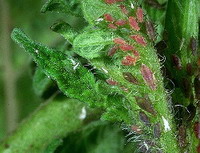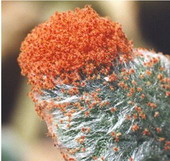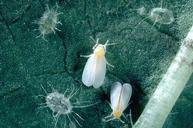Identify and Control Indoor Tomato Pests
Since 2010, Tomato Dirt has garnered 4.8+ million views, making it the web’s leading online source for growing tomatoes in the home garden. Award-winning writer and Tomato Dirt owner Kathy Widenhouse has helped thousands of home gardeners grow healthier tomatoes. Be one of them when you get Tomato Dirt’s Growing Guide here.
Be on the lookout for indoor tomato pests that can attack your plants – most often aphids, spider mites, and whiteflies. With a little bit of care you can control them and keep your tomato plants healthy.
How do indoor tomato plants get infested with pests?
Most often, pests ride along with when outdoor plants are brought inside or nursery plants are brought home.
Outdoors pests have to contend with wind, rain and predators. Indoors, they are sheltered. It's a comfortable place to be.
A good first step to clearing up indoor tomato pests from plants is to put them outside for a while, weather permitting.
Methods to treat and control indoor tomato pests
Indoors, only non-toxic controls are acceptable since humans occupy the same space as plants. Use these methods in combination to control pests and keep indoor tomato plants healthy.
• Spray with water. Wash tomato plant with a strong jet water stream, which causes insects (particularly aphids) to dislodge and move on. Water spraying removes one generation of insects but leaves room for the next. Spray several days in a row to eradicate as many generations as possible. Set plant outdoors (weather permitting), in a utility sink, or in a tub while spraying.
Aphids on indoor tomatoes
How to identify aphids
 |
Photo: University of Kentucky |
What aphids do to indoor tomatoes
Aphids attack the tip of the stems and the leaves, sucking out plant sap. Affected plants may wilt, drop leaves, or have yellowing leaves. Look for a light-colored residue (“honeydew”) on leaves and stems, which can turn black and promote the growth of mold. Aphids on tomatoes reduce tomato quality, fruit yield, and can cause stunted growth.
How to control aphids indoors
If possible, identify and control aphids in the early stages, since they multiply rapidly and will spread over your entire plant and to other plants, too. Aphids will start to produce live young almost as soon as they are born.
- Spray plants regularly with a jet stream of water to dislodge aphids.
- Set out yellow sticky traps around plants or insert sticky stakes in the container to thwart them.
- Apply an organic insecticidal soap, such as Safer®
- Apply horticultural oil, such as Neem oil, to control aphids.
Spider mites on indoor tomatoes
 |
Photo: Tulsa Master Gardeners |
How to identify them
Spider mites are tiny, single-bodied insects about 1 mm long – almost microscopic. Look for them on leaf undersides. You may even need a magnifying glass.
What spider mites do to indoor tomatoes
Spider mites pierce leaves and feed on plant sap, beginning on leaves’ undersides.
They work from the lower part of the plant to upper leaves. Small wounds on plants that look like white specks tell you that spider mites have been hard at work. If left unchecked, affected leaves develop a bronze or gray color, turn brown, and fall off.
Spider mites also leave their signature webbing strung between plant parts or beneath leaves. They are active year- round.
How to control spider mites indoors
Spider mites are difficult to control and have stumped many a tomato gardener. With a life cycle of 1-2 weeks in optimum conditions, spider mites multiply rapidly and feed continuously. Identify and control spider mites quickly to prevent them from spreading through your entire indoor tomato crop.
- Spray plants regularly with a jet stream of water to dislodge spider mites.
- Apply horticultural oil (like neem oil) to control spider mites. Oils are only effective when wet, so repeat applications at systematic intervals to eliminate a colony.
- Insecticidal soaps are considered to be only marginally effective on spider mites. Like neem and other horticultural oils, insecticidal soaps like Safer® work on pests when wet. Apply them repeatedly to eliminate spider mites.
- Commercial and greenhouse growers have had consistent success controlling spider mites with avermectin, a natural product derived from soil microorganisms and the active ingredient in Avid and Floramite.
Whiteflies on indoor tomatoes
 |
Photo: University of California IPM |
How to identify them
- Shake your tomato plant. If dozens of tiny white or light-colored insects break free, they are likely whiteflies.
- Look for whiteflies’ telltale trail of sticky white dew (called “honeydew”) on leaves, stems, and fruit.
- Check leaves for circular or spiral light-colored designs, which are actually strings of whitefly eggs.
What whiteflies do to indoor tomatoes
Whiteflies suck juices from leaves, causing wilting, leaf damage, brown leaves, and stunted growth. If left unchecked, white flies can quickly defoliate your indoor tomato crop.
How to control whiteflies indoors
- Use a handheld vacuum to eliminate whiteflies by hand.
- Set out yellow sticky traps around plants or sticky stakes in containers to thwart them.
- Apply an organic insecticidal soap, such as Safer®
- Apply horticultural oil, like Neem oil, to control whiteflies.
More on growing tomatoes indoors
How to Identify These 13 Common Bugs on Tomato Plants ...
Aphids on tomato plants: how to identify and control them ...
How to grow indoor tomatoes ...
Best indoor tomato varieties ...
How to grow tomatoes on a windowsill indoors ...
How to take tomato cuttings to grow indoors ...
Tomato grow lights explained ...
Using fluorescent grow lights to start seeds, grow tomatoes ...
Fluorescent grow light systems to choose from ...
Growing indoor tomatoes FAQs: Frequently Asked Questions...
How to identify tomato pests and control them ...
Return from Indoor Tomato Pests to Tomato Dirt home
As an Amazon Associate and Rakuten Advertising affiliate I earn from qualifying purchases.
SHARE THIS PAGE:
FREE! 10 Must-Know Tomato Growing Tips: 20-page guide
Get yours here:




New! Comments
Have your say about what you just read! Leave a comment in the box below.